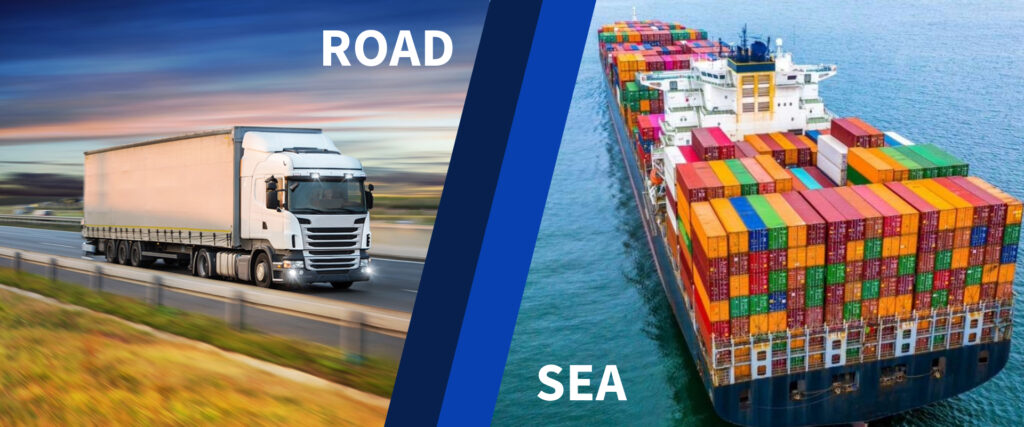This came all the way from China without being damaged, but you couldn’t even deliver it from Durban to Pietermaritzburg in one peace.

How often do road freight companies hear this complaint?
Packaging for Sea Freight vs. Road Freight: Key Differences and the Impact of Dynamic Load Factors
When shipping goods, the mode of transport used plays a crucial role in determining the type of packaging required. Sea freight and road freight differ significantly in terms of the environmental conditions and physical forces exerted on the cargo. One of the key considerations in packaging for both modes of transport is the concept of dynamic load factors—forces that act upon the freight during transit due to movement, vibrations, and external conditions.
Understanding Dynamic Load Factors
Dynamic load factors refer to the varying forces that goods experience in transit due to acceleration, deceleration, vibration, and external influences such as waves or road irregularities. These forces impact how cargo must be packaged to prevent damage and ensure safe delivery. The main dynamic load factors include:
- Vertical Loads: The weight of the cargo pressing down on packaging materials and pallets, often intensified by stacking.
- Lateral (Side-to-Side) Loads: Forces exerted due to swaying, braking, and cornering.
- Longitudinal Loads: Forces caused by sudden stops and starts.
- Environmental Factors: Changes in temperature, humidity, and exposure to saltwater (for sea freight) or road debris (for road freight).
Packaging for Sea Freight
Sea freight presents few challenges other than exposure to moisture, and significant movement from ocean waves.
The other area where damage could occur is where goods transported via sea are exposed to high humidity and salt-laden air, which can cause corrosion, mould, and degradation of packaging materials. This is rarely the case though, with reputable shippers.
Freight generally survives sea journeys because ocean shipping containers and vessels are specifically designed to protect goods from external elements such as moisture, temperature changes, and movement.
Containerized sea freight differs significantly from road freight due to the uniformity and standardization of packaging in sea transport, whereas road freight involves a varied mix of cargo types and shapes.
With sea freight, goods are packed into standardized TEU shipping containers (e.g., 6m-(20ft) or 13m (40-ft) containers), making the freight more uniform in size, shape, and stacking. These containers are designed to fit securely on ships, minimizing movement and damage.
Packaging for Road Freight
Road freight packaging needs to withstand different dynamic load factors compared to sea freight, primarily caused by vehicle movement on varying road surfaces. The key considerations include:
Impact and Vibration Protection
It is estimated that less than 70% of paved roads in South Africa are in excellent condition and more than 50% of the unpaved roads are in poor condition (Frost & Sullivan report)
Trucks experience constant vibration due to road conditions, potholes, and sudden braking. Damaged or poorly maintained roads with potholes, uneven surfaces, and cracks create continuous vibrations and sudden shocks for trucks. These impacts can cause cargo to shift, topple, or break, especially if it is not properly secured.
Stacking and Weight Distribution are factors that affect cargo as it is often stacked in truck trailers, requiring the appropriate sturdy packaging to withstand pressure from loads above.
However, if goods are not properly prepared for road freight, they are more likely to get damaged due to the following factors:
- More Frequent Handling – Goods in road freight are often loaded and unloaded multiple times at different depots, increasing the risk of mishandling or improper stacking.
- Vibrations and Shocks – Trucks experience continuous vibrations from rough roads, potholes, and sudden braking, which can cause unsecured goods to shift, fall, or break.
- Uneven Load Distribution – Unlike ocean shipping, where containers remain in a relatively stable position, road freight involves constant acceleration, deceleration, and turns, which can lead to goods moving around if they are not properly secured.
- Weather Exposure – While sea freight containers are sealed and protected, road freight may involve exposure to rain, dust, or extreme temperatures, especially if transported in open or poorly covered trucks.
- Lack of Standardized Packaging – Many goods shipped by sea are packed in standardized containers designed for long journeys. If those same goods are transported by road without additional protective packaging (such as pallets, shrink wrap, or cushioning), they are more vulnerable to damage.
- Stacking and Compression Risks – In sea freight, containers are stacked carefully, and goods inside them are often well-secured. In contrast, road freight may involve stacking that isn’t optimized for long journeys, leading to crushing or toppling.
Conclusion
Road freight consignments present unique challenges that require tailored packaging solutions. While sea freight demands moisture-resistant, impact-proof packaging capable of withstanding long-term exposure to environmental conditions, road freight packaging in addition, must focus on impact absorption, stacking durability, as well as weather protection.
Understanding the dynamic load factors affecting each mode of transportation and preparing the cargo accordingly, ensures that cargo arrives safely and intact, minimizing losses and enhancing supply chain efficiency.
Key Differences in Packaging Between Sea and Road Freight
| Factor | Sea Freight Packaging | Road Freight Packaging |
| Moisture Exposure | High (humidity, saltwater) | Moderate (rain, road debris) |
| Shock and Vibration | Rolling, pitching movements | Bumps, potholes, sudden braking |
| Stacking Requirements | High durability for long transit and stacking | Sturdy packaging for road stacking |
| Temperature Sensitivity | Long-term exposure to fluctuating temperatures | Short-term variations, extreme cold/hot weather |
| Packaging Material | Waterproof, corrosion-resistant, reinforced crates | Shock-absorbing, weather-resistant, strong cardboard boxes |